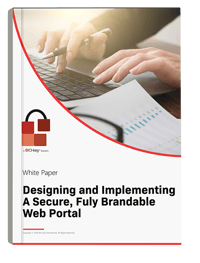Like the blog? Read the whitepaper!
Most portals are designed for their function and only provide the basics when it comes to security, but with the increase in cyberattacks, this is no longer enough.
What is a Portal?
From a simple definition, a portal is a website that provides users with access to information from various sources in a single location. In this case, a portal acts as the gateway that connects the user to the resources that they are looking for with as minimal hassle as possible.
When it comes to login and authentication-based purposes, a portal connects a user to all of the applications their organization uses, i.e. Adobe Suite, Google Suite, Microsoft Office, etc. In recent years, there have been many more questions about "how can I secure a portal?" and "what can it do for me?". As various industries and departments are looking for their own version of a web portal, many of them do not fully comprehend the true benefits of having one. Understanding why a portal is important and how to make it work for you will provide the best experience for your digital environment.
A Seamless Integrated Secure Portal
While there is no doubt that the end-user experience is a primary driver in designing the ideal portal, it needs to balance security and usability to provide the best user experience possible, while securing sensitive data. Designing this ideal portal is different for every organization and considers numerous factors, especially: security, compliance, design, and integration.
Security
To address security, your environment should first consider access control, ACL (Access Control List) management, and content verification. More importantly, you should ask yourself, "What security features do I need?" Security should never be an afterthought when integrating a portal into your environment. The choice between various security methods is the choice of improving user experience versus enhancing security measures.
To secure sensitive data, your portal should be a place where the worlds of the public portal and private portal collide into a single, seamless experience. Securing sensitive data through a portal requires a new series of questions, in particular on how to access that data. Having a main goal of improving user experience means that streamlining application access is a priority.
An industry example would be designing a portal with Single Sign-On capabilities that offers administrators and users great benefits. This central access point to web apps gives users the convenience of maximizing their portal experience and efficiency. Even with this direction, there are still advantages and disadvantages to consider.
Compliance
Regardless of your industry, there will always be security requirements directly related to compliance considerations. Security and compliance requirements work hand-in-hand, often working on one another. Compliances like HIPAA, FERPA, GLBA, or COPPA have a major influence on the security standards and the design and implementation of the portal.
Unfortunately, compliance standards can make or break the installation of a new software solution, so many organizations need to address these concerns now so that more issues do not need resolving down the line.
Integration
While organizations need to address security and compliance requirements, they also need to understand the design and integration points. Even if a portal has proper security and fulfills the required compliance requirements, users will not be willing or know how to properly use the secure web portal if it is not user-friendly or has difficult functionality.
End-User
Speaking of the functionality, the location of the login itself plays a large role in the integration. Additionally, 'brandability' and customization are huge benefits that not only improve the usability of the website but also provide end users with a consistent look and feel while navigating through familiar territory.
A well-designed portal allows users to deliver pertinent information in an efficient and accessible way, and simple add-ons like branding, color scheme, and fonts serve to convey a reassuring message of corporate consistency on the user's behalf.
Conclusion
The digital marketplace is a continually evolving community of applications and services that exist to improve every aspect for the end-user. Typically, portals provide a variety of options aimed at convenience and while that's a great service to users, security should never be an afterthought. As more organizations migrate to work from home and a digital environment, establishing a web portal that is user-friendly and secure is a large leap in improving the overall digital experience.
Here's a whitepaper with more details about a portal's functionality, the different types of portals organizations will encounter, and more details on how to seamlessly implement a fully branded secure web portal.
Learn how to secure your portal without compromising on convenience
In this whitepaper you'll discover how to address your security requirements while meeting the needs of your users.


